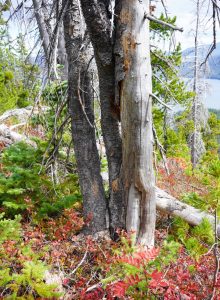Reconstructing historic fire activity and whitebark pine distributions in Tweedsmuir Provincial Park North
Categories:

Kira Hoffman, UBC and Bulkley Valley Research Centre, Alana Clason, Bulkley Valley Research Centre, and Lori Daniels, UBC
Tweedsmuir Provincial Park North is British Columbia’s largest protected area and located in the remote and roadless west-central portion of the province about 500 km from Vancouver, and
is within the traditional territory of the Cheslatta Carrier Nation who have stewarded the land since time immemorial.
In 2017 and 2018, approximately half of the forests that comprise Tweedsmuir Provincial Park were lost to severe wildfires. These wildfires burned primarily through lower elevation sub-boreal forests, but large areas of high-severity fire also impacted subalpine and treeline ecosystems across the mountainous provincial park. Longer, hotter, and drier wildfire seasons are becoming commonplace in BC and subalpine ecosystems that were previously considered fire refugia (areas that remain unburned or minimally affected by fire), are now burning under prolonged extreme fire weather. More research is needed to understand historic fire activity and preserve evidence of historic fire events that are preserved in fire-scarred trees before these records are erased by future wildfires.
Endangered species such as whitebark pine (Pinus albicaulis) are at risk from increasingly severe wildfires as a result of over a hundred years of fire suppression and a rapidly changing climate. Whitebark pine is a long-lived high elevation tree species experiencing extensive mortality throughout western North America from an invasive pathogen and the recent large-scale outbreak of mountain pine beetle.

To understand the impacts of changing fire activity on sub-boreal and subalpine forests, we reconstructed the frequency and seasonality of historic fire activity in old growth whitebark forests (>250 years old) of Tweedsmuir Provincial Park North. Reconstructing historic fire activity was done with a chainsaw that was used to cut small “pies or cookies” from trees where scars had formed when the tree survived a low-severity fire event (see picture below). These scars are embedded in the annual tree growth rings that a tree puts on each year. Trees are like big thermometers and can provide data on past climate conditions such as drought, heavy snowpack and cool and wet summers. We can use this data to understand the climatic conditions that may have contributed to fire events. We put all these fire scars on a map to understand how big the fires were and where they burned. Sites were mostly located along lake edges and on islands, with two ridgeline sites surveyed. The fire history record extended 750 years, with 25 fire events recorded over a 250 – year period (1711-1953).
This is the first fire history reconstruction completed in the park and results indicate two key findings. First, all 11 study sites recorded low-severity fire, with a composite mean fire return interval of 10 years across sites (range 1-55 years). Second, results highlight centuries of Indigenous fire stewardship, which in combination with lightning-ignited wildfires comprised the historic fire regime of these ecosystems. Supporting Indigenous-led fire stewardship and the reintroduction of low-severity fire to lower elevation subalpine forests may create forest and fuel conditions that could protect these ecosystems from increasingly severe wildfire events, as well as providing regeneration habitat for whitebark pine. Research findings highlight the need to manage wildfire together with multiple ecological and cultural values in old growth protected areas.
—–
This project was funded in part by the BC Parks Living Lab Program. The Program promotes the province’s protected areas as places to learn about the impacts of climate change, how to mitigate and manage those impacts, and to share information between academics and practitioners.
Learn More: For more information on the Living Lab Program and the criteria for funding applications, visit: http://www.env.gov.bc.ca/bcparks/partnerships/living-labs/




